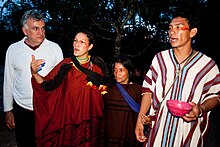Asháninka
 | |
| Total population | |
|---|---|
| between 25,000 and 45,000 | |
| Regions with significant populations | |
| Peru, Brazil | |
| Languages | |
| Asháninka |
The Asháninka or Asháninca are an indigenous people living in the rainforests of Peru and in the State of Acre, Brazil. Their ancestral lands are in the forests of Junín, Pasco, Huánuco and part of Ucayali in Peru.
Population

The Asháninka are estimated between 25,000 and 45,000. Only a few hundred of these live on the Brazilian side of the border. The Ashaninka communities are scattered throughout the central rainforests of Peru in the Provinces of Junin, Pasco, Huanuco and a part of Ucayali, and the state of Acre.
Subsistence
The Asháninka are mostly dependent on subsistence agriculture. They use the slash-and-burn method to clear lands and to plant yucca roots, sweet potato, corn, bananas, rice, coffee, cacao and sugar cane in biodiversity-friendly techniques. They live from hunting and fishing, primarily using bows and arrows or spears, as well as from collecting fruit and vegetables in the jungle.
History

The Asháninka were known by the Incas as Anti or Campa. The Antis, who gave their name to the Inca province of Antisuyu, were notorious for their fierce independence, and their warlike skills in successfully protecting their land and culture against intrusion from outsiders.
Ashanínka tribal societies have faced overwhelming obstacles in disputes over territory and culture against the immigrating Spanish culture and neighboring tribal societies .Biodiversity is the establishment of the Ashanínka way of life, so they treat this biodiversity hotspot as their 'natural capital.'In AD 1542 the European settlers pushed to overtake the natural resources .In June 2010, however, the Brazilian and Peruvian governments signed an energy agreement that allows Brazilian companies to build a series of large dams in the Brazilian, Peruvian, and Bolivian Amazon." The problem with the 2,000-megawatt Pakitzapango Dam is that it has a permanent location that is proposed to be located in the heart of Peru's Ene valley could displace as many as 10,000 Ashanínka. These encroaching problems have not only extremely changed the generational culture of the Ashanínka tribal societies, but has also changed landscape of what we call modern-day Peru.
Traditional dress
They are of fine physique and generally good-looking. Their dress is a robe with holes for the head and arms. Their long hair hangs down over the shoulders, and round their necks a toucan beak or a bunch of feathers is worn as an ornament.
The Asháninka traditional dress, commonly known as a kushma from, is a robe made from cotton that is collected, spun, dyed and woven by women on looms. Typically the robes are dyed either brown or a bright royal blue. The shoulders of the garments are ornamented with seeds. A full length robe can take up to three months to complete.

Traditionally, women wear their hair long, and over the shoulder, While typically men wear their hair short or in "bowl" cuts below the ear. Around their necks they wear a large variety of necklaces and bracelets made with seeds, the teeth of tapir, peccary and monkeys, and brightly colored feathers.

Traditionally the Asháninka men, women and children paint their faces in a variety of designs using the bright red crushed seeds of Achiote (Bixa orellana) (annatto) fruits. For ceremonial purposes, the men also wear woven circles of palm leaves decorated with feathers on their heads, and the women wear a woven cotton head dress.
Threats
The Asháninka are known historically to be fiercely independent, and were noted for their "bravery and independence" by the Spanish conquistadors. During the rubber boom (1839–1913), the Asháninka were enslaved by rubber tappers and an estimated 80% of the Asháninka population was killed.
For over a century, there has been encroachment onto Asháninka land from rubber tappers, loggers, Maoist guerrillas, drug traffickers, colonisers, and oil companies.
Malaria is on the rise in Asháninka communities.Current threats (either directly or indirectly) are from oil companies, drug traffickers, colonists, illegal lumberers, illegal roads, and diseases brought by outsiders.
References
This article needs additional citations for verification. (August 2017) |
- ^ One or more of the preceding sentences incorporates text from a publication now in the public domain: Chisholm, Hugh, ed. (1911). "Anti". Encyclopædia Britannica. Vol. 2 (11th ed.). Cambridge University Press. p. 120.
